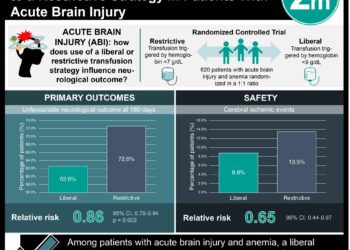Mortality after trauma increasingly due to preexisting conditions
Image: PD
1. From the year 2000 to 2011, the mean age of patients who died on the trauma service increased from 47.0 to 56.7 years of age.
2. During the same time interval, deaths due to preexisting medical conditions only and survivable trauma combined with complications of preexisting medical conditions increased from 3.3% to 20.9% and from 6.7% to 16.4% respectively.
Evidence Rating Level: 2 (Good)
Study Rundown: As innovations in trauma management advance, the most common causes of death following trauma have changed as well. Improvements in resuscitation, operative management and treatment guidelines have significantly improved outcomes. However, the patient population has increased in age, and patients now more commonly have preexisting medical conditions. This study demonstrated that as the mean age of trauma patients increased, the rate of deaths due to preexisting medical conditions (PM) and survivable trauma combined with complications of preexisting medical conditions (TCoM) increased. Deaths due to traumatic brain injury or high spinal cord injury (TBIC) and multiorgan failure, sepsis or adult respiratory distress syndrome (MOF/S/ARDS) decreased. This study is limited in several aspects. First, this is a single center study, which may not be generalizable to other trauma centers. Although the authors claim that there was an increase in number of deaths due to preexisting medical conditions, data pertaining to the comorbid conditions these patients had is not available. Furthermore, there were only 15 deaths due to multiple organ failure, sepsis, or adult respiratory distress syndrome. Although the decrease in incidence reached statistical significance, the low sample size of this group is concerning.
Click to read the study in The Journal of Trauma and Acute Care Surgery
Relevant Reading: The epidemiology of traumatic death. A population-based analysis
In-Depth [retrospective study]: This study examined 842 patients admitted to the trauma service of a level 1 trauma center who died following their injury. All deaths were evaluated at the center’s monthly morbidity and mortality conference and reviewed by the county medical examiner. The causes of death were classified into several categories. Next, major changes in the the trauma surgery service’s practices during the study period were analyzed. It is significant to note the adoption of four new treatment guidelines during the study period, including lung protective ventilation (2002), increased venous thromboembolism screening and prophylaxis (2002), damage-control resuscitation techniques (2007), and use of fresh frozen plasma limited to male donors to reduce transfusion related acute lung injury (2007).
During the study period, the percentage of elderly and severely injured patients increased from 10.8% to 25.5% (p<0.001), and from 14.1% to 19.0% (p=0.001) respectively. Concurrently, there were increasing trends in the prevalence of Charlson comorbidities, while there was a decreasing trend in all-cause annual mortality rates. Over the study period, the mean age of patients who died on the trauma service increased from 47.0 to 56.7 years of age. The most common causes of death after traumatic injury were traumatic brain injury or high spinal cord injury (44.3%) and acute hemorrhagic shock (28.3%). Deaths due to preexisting medical conditions only and survivable trauma combined with complications of preexisting medical conditions increased from 3.3% to 20.9%, and from 6.7% to 16.4% respectively. Deaths caused by multiple organ failure, sepsis, and adult respiratory distress syndrome decreased from 5% in 2000 to 0% in 2007.
By James Jiang and Allen Ho
More from this author: Physical examination sufficient to evaluate abdominal stab wounds, Mortality risk higher in pediatric trauma patients with chronic conditions, Patient transfers to trauma centers often unnecessary, Postoperative complications linked with unplanned hospital readmissions, Plasma-Lyte A improves acid-base status in adult trauma patients
© 2013 2minutemedicine.com. All rights reserved. No works may be reproduced without expressed written consent from 2minutemedicine.com. Disclaimer: We present factual information directly from peer reviewed medical journals. No post should be construed as medical advice and is not intended as such by the authors, editors, staff or by 2minutemedicine.com. PLEASE SEE A HEALTHCARE PROVIDER IN YOUR AREA IF YOU SEEK MEDICAL ADVICE OF ANY SORT.







